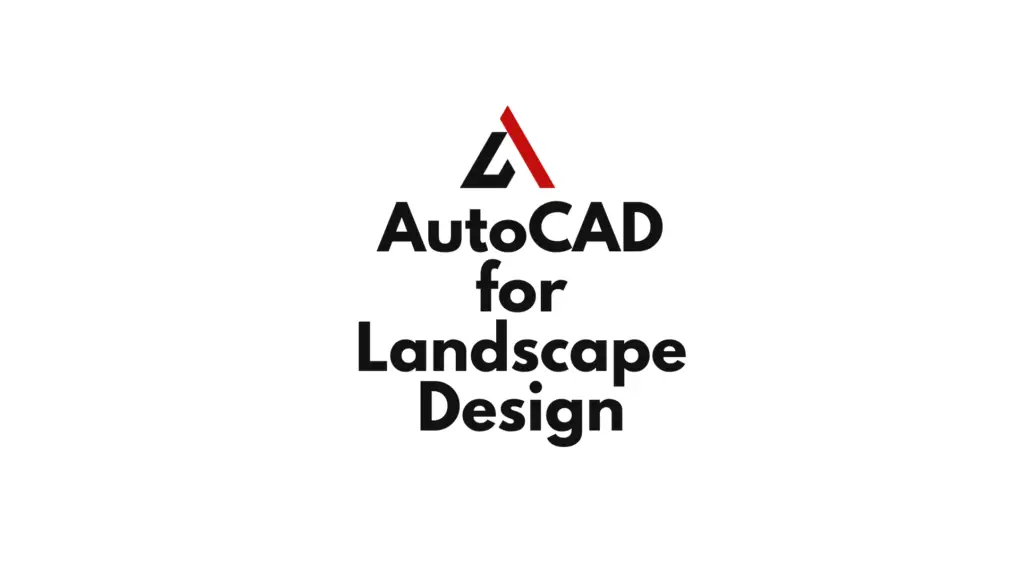AutoCAD has long been the go-to tool for professionals in architecture and engineering, but its robust features also make it an indispensable asset for landscape design. Whether you’re a seasoned landscape architect or a newcomer to the field, understanding the application of AutoCAD in landscape architecture can significantly enhance the precision and creativity of your site plans and garden designs. From conceptualizing large-scale parks to detailing intricate garden layouts, AutoCAD offers a powerful platform for turning ideas into actionable plans.
This article will explore how we can use AutoCAD for landscape design architecture, focusing on site planning and garden design. We will cover the essential tools, techniques, and workflows that will help you create stunning, accurate, and efficient landscape designs.
Table of Contents
Introduction to AutoCAD for Landscape Architecture
Landscape architecture is the art of designing outdoor spaces in a way that balances aesthetics with functionality, sustainability, and environmental concerns. When designing landscapes, precision is key to ensuring that elements such as pathways, water features, and plantings are integrated harmoniously into the environment. AutoCAD helps landscape architects achieve this precision by offering an array of tools for drafting, modeling, and documenting landscape designs.
In the world of landscape architecture, site planning and garden design are two critical areas where AutoCAD excels. Whether you’re designing a public park, a residential garden, or a corporate campus, AutoCAD provides the framework to visualize and execute your ideas with clarity.

Why AutoCAD for Landscape Design?
AutoCAD is widely used across industries for its precision, scalability, and flexibility. For landscape architects, AutoCAD’s features enable the creation of both detailed and large-scale drawings that communicate essential information to clients, contractors, and stakeholders. Here are a few reasons why AutoCAD is an ideal tool for landscape design:
- Accurate site measurements: AutoCAD ensures your designs reflect the real-world dimensions and topographical data, crucial for any landscape project.
- Customizable templates and libraries: You can create or import specific landscape elements such as trees, shrubs, and hardscape features to speed up the design process.
- Advanced layering capabilities: This feature helps organize your drawings, making it easier to work on various aspects of the design without losing focus or cluttering the workspace.
- 3D capabilities: While 2D designs are essential, AutoCAD’s 3D modeling tools allow you to visualize elevations, slopes, and vertical structures like pergolas or retaining walls.
Setting Up a Landscape Design Project in AutoCAD
Starting a New Landscape Drawing
When starting a new project, the first step is setting up the workspace correctly. For landscape architecture, this means configuring units, scale, and layers to reflect the scope and needs of your design.
- Start a new drawing in AutoCAD by selecting the appropriate template, typically in feet or meters depending on the region and project requirements.
- Set up units to reflect real-world measurements. For landscape designs, using feet or meters is standard practice.
- Use the LAYER command to create separate layers for important components such as plants, hardscape, water features, and site boundaries. These layers help keep the design organized and allow for easy editing later on.
Importing Site Plans and Topographical Data
For most landscape architecture projects, you’ll start by importing a site survey or topographical data. This data helps you understand the existing conditions, such as the slope of the land, elevation changes, and any existing structures or vegetation. Here’s how to import and use external reference data:
- Use the XREF command to import a site plan or topographical map.
- If you’re working with contour lines or elevation data, you can convert this information into a 3D surface using AutoCAD’s 3D Modeling tools. This is particularly useful for site grading and drainage design.
With the basic layout and site information imported, you can begin adding landscape elements.
Site Planning with AutoCAD
Defining Boundaries and Zones
Site planning involves organizing space within a site to accommodate different functions, such as recreational areas, circulation paths, water features, and planting zones. In AutoCAD, the POLYLINE tool is often used to outline boundaries, walkways, and other critical site components. You can also use HATCH patterns to visually differentiate different types of surfaces, such as grass, gravel, or pavement.
- Use the POLYLINE command to outline the site boundary and major zones such as lawns, planting beds, patios, or decks.
- Apply HATCH patterns to distinguish between hardscape and softscape areas. For example, you might use a brick pattern for walkways and a grass pattern for lawn areas.
- Use OFFSET to create consistent buffer zones around important features like buildings or water bodies, ensuring that planting and hardscapes respect required setbacks.
Designing Pathways and Circulation
Circulation design, which involves the layout of paths, walkways, and driveways, is an essential component of landscape architecture. AutoCAD’s tools for drawing curves, straight lines, and angles allow for the precise design of meandering garden paths or geometrically aligned driveways.
- Use the SPLINE command to create organic, free-flowing paths that wind through a garden or natural landscape.
- For more structured designs, use the LINE tool to create grid-like layouts or straight walkways.
- Incorporate RADIUS and FILLET commands to soften the edges of paths, making them more pedestrian-friendly.
Once the pathways are in place, you can add surface materials using hatch patterns to distinguish between different surfaces, such as gravel, brick, or flagstone.
Site Grading and Drainage Design
One of the most challenging aspects of landscape architecture is site grading, which involves modifying the contours of the land to manage water flow, ensure accessibility, and create visually pleasing slopes. AutoCAD offers several tools that make grading and drainage design easier to manage.
- Contour Lines: If you’re working with a sloped site, start by importing contour lines or creating them manually using the POLYLINE tool. Each line represents a different elevation.
- Surface Modeling: Use AutoCAD’s 3D tools to create a surface model of the terrain. This is especially useful for visualizing how water will flow across the site.
- Drainage Features: Incorporate drainage elements such as swales, storm drains, or permeable surfaces into the design to manage runoff effectively.
Garden Design in AutoCAD
Planting Plans and Landscape Symbols
Garden design is a crucial part of landscape architecture, involving the selection and placement of plants, trees, and shrubs. In AutoCAD, you can create planting plans that detail the types of plants, their locations, and their spacing. AutoCAD’s block feature allows you to insert pre-drawn plant symbols or create your own custom plant blocks.
- Insert Plant Symbols: Use the BLOCK command to insert standardized symbols for trees, shrubs, or flower beds. You can either use AutoCAD’s library or create custom blocks to represent different plant species.
- Layer Management: Create separate layers for different plant categories, such as trees, shrubs, and groundcovers. This allows you to easily turn plant layers on and off while working on other aspects of the design.
- Annotations: Use the TEXT tool to label plants with their common or botanical names. Additionally, you can add LEADERS to indicate important information such as spacing requirements or planting instructions.
Hardscape Features
In addition to plants, landscape designs often include hardscape elements such as patios, decks, retaining walls, and water features. AutoCAD’s precision drafting tools make it easy to incorporate these features into your design.
- Drawing Patios and Decks: Use the RECTANGLE or POLYLINE commands to draw hardscape features like patios or decks. You can apply HATCH patterns to represent different surface materials, such as wood decking, concrete, or stone.
- Retaining Walls: Use the LINE tool or POLYLINE tool to design retaining walls. In sloped areas, retaining walls are essential for managing changes in elevation. You can use the OFFSET tool to create parallel lines that represent the thickness of the wall.
Water Features and Lighting
Water features such as ponds, fountains, and pools are popular elements in garden design. AutoCAD allows you to design these features with precision.
- Ponds and Fountains: Use the CIRCLE or ELLIPSE tools to draw the basic shapes of ponds or fountains. You can also apply water hatch patterns to visually represent water features in your plan.
- Lighting Plans: Landscape lighting is essential for both aesthetics and safety. Use the INSERT command to add lighting symbols to your design. You can represent different types of lighting, such as path lights or uplights, using different symbols and layers.
Annotating and Dimensioning the Landscape Design
Clear annotations and accurate dimensions are crucial for communicating design intent. AutoCAD’s annotation tools make it easy to add this information to your landscape plan.
- Adding Dimensions: Use the DIMENSION tool to add measurements to critical features, such as the width of pathways, the diameter of planting beds, or the spacing between trees.
- Text and Labels: The TEXT tool allows you to label different parts of the garden, such as seating areas, water features, or plant species. Use layers to organize your text, ensuring that your annotations are clear and not cluttered.
Suggested – Architectural Floor Plans in AutoCAD
Finalizing and Exporting the Landscape Design
Once your design is complete, it’s time to finalize the drawing and export it for presentation or construction.
- Layer Control: Make sure all layers are properly named and organized. Turn off any unnecessary layers before printing.
- Plotting: Use AutoCAD’s PLOT command to print the design. You can print in PDF format for digital sharing or produce physical prints for on-site reference.
- Exporting: Export the drawing as a DWG file for use in other CAD programs or as a PDF to present the final design to clients.
FAQs
Why is AutoCAD essential for landscape design?
AutoCAD provides precision, scalability, and customization options, making it ideal for creating accurate landscape designs. It supports both 2D and 3D views, allowing landscape architects to visualize topography, site elements, and plant layouts.
Can AutoCAD handle both large-scale site planning and detailed garden design?
Yes, AutoCAD excels in both large-scale site planning and intricate garden layouts. Its flexible tools allow for the integration of site topography, drainage design, and plant symbol libraries, making it suitable for projects of all sizes.
How does AutoCAD handle topographical data in landscape design?
AutoCAD can import topographical data through external references and convert it into a 3D model. This feature is especially useful for grading, drainage design, and understanding site elevations.
Is AutoCAD suitable for residential garden design?
Absolutely. AutoCAD offers a range of tools that simplify residential garden design, including templates for planting plans, hardscape elements, and lighting plans. It allows for detailed customization, ensuring that the final design reflects both aesthetic and functional goals.
Can AutoCAD be used for sustainable landscape design?
Yes, AutoCAD can incorporate sustainable landscape features like rain gardens, permeable paving, and native planting zones. By modeling site grading and water flow, you can ensure your design supports sustainable practices.
What is the difference between AutoCAD and AutoCAD LT for landscape architecture?
AutoCAD LT lacks 3D modeling and advanced customization tools found in the full version of AutoCAD. While AutoCAD LT is sufficient for basic 2D landscape design, the full version is better suited for complex site grading, drainage modeling, and 3D visualizations

